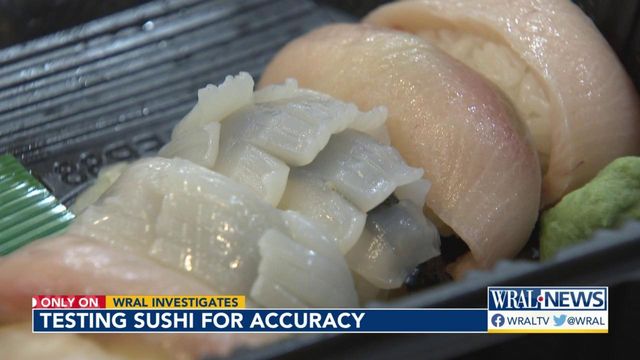Endangered shark? Wrong bass? WRAL Investigates puts local sushi to the DNA test
WRAL Investigates bought dozens of pieces of sushi to see if the description on the menu is the same fish you get on your plate.
Love it or hate, sushi continues to grow in popularity. Sushi sales are up about 16% since before the pandemic, according to industry research group IBISWorld.
From high-end restaurants to strip malls to grocery stores, WRAL Investigates documented what was bought according to the menu description, cut samples off the sushi and put the fish in numbered test tubes, washing the scissors and laboratory tweezers between each sample.
WRAL Investigates put the samples in the freezer until the fish was delivered to our "scientists," a seafood forensics class at the University of North Carolina at Chapel Hill
John Bruno is the biology professor who teaches the class. Even though he no longer eats seafood, Bruno has a vested interest in what the rest of us are eating that comes from the sea.
"Mislabeling is a really big problem globally," Bruno said.
WRAL Investigates first met Bruno a couple of years ago, when WRAL News tested store and restaurant seafood that claimed to be from our coast. With this latest round of testing, WRAL News discovered you need to be careful about not only where your seafood is from — but what it is.
"Red snapper is almost always mislabeled," Bruno said about WRAL’s previous research. "Squid and octopus can be mislabeled."
WRAL’s sushi samples provided Bruno’s students with their big project this semester.
Bruno explained the process of identifying the sushi using DNA barcoding.
"The first thing you have to do is extract the DNA out the cell," he explained. "[We only need] about a pea-size piece of seafood tissue, then we warm the tissue up. Once we get it separated, we amplify it."
The DNA is then sent to a local lab where it’s sequenced so it can be compared to massive database of fish DNA to detect the exact species.
So how did the sushi do? Out of 27 pieces of tested fish, four were mislabeled, or about 15% of the samples.
The most surprising result was a piece of white tuna from a Cary restaurant. It was tested twice and both times came back as endangered scalloped hammerhead shark. WRAL Investigates reached out to the restaurant with the results but has not heard back.
A piece of popular striped sea bass came back as a different type of bass. The striped bass is supposed to be wild-caught in the ocean, but the bass WRAL News received was likely farm raised in fresh water, testing uncovered.
Previous studies have found salmon is usually correctly labeled. So far, WRAL News only has results for one out of four salmon samples, which did come back as correctly labeled Atlantic Salmon.
WRAL News also found several other menu items that weren’t wrong, but they weren’t right either. That’s particularly the case with tuna, the reddish-pink fish you find in many types of sushi. From bigeye to yellowfin to albacore, there are a lot of different species of tuna.
"A lot of seafood products are what we call soft mislabeled," said Bruno, who pointed to tuna as the main culprit in the sushi world.
However, WRAL Investigates found tested high-end, expensive blue fin tuna was correctly labeled on local menus 100% of the time.
Bruno said the 15% mislabeling rate is actually better than what similar projects have found across the country.
"On average, only about 20% of seafood is mislabeled, but for some types of seafood, like red snapper, nearly 100% is mislabeled," Bruno said.
Tracking where that mislabeling happens is difficult. It could be on the boat, the distributors or the restaurants.
While Bruno said there is no easy fix, he believes there’s a good starting point.
"There are a couple things we can do to reduce mislabeling," he said. "We need local, state and federal legislation that makes it illegal to mislabel, and we need enforcement of that."
With sushi’s growing popularity and increasing price, Bruno said better regulation ensures fish stocks are better monitored so customers get what they pay for.
"You’re paying for a BMW but you got a used Toyota," Bruno used as an example. "That’s why you should care."
Some states like Florida and Louisiana have enacted legislation to crack down on seafood mislabeling.
The United States Department of Justice has also targeted several distributors in the past couple of years for passing off foreign seafood as caught in the United States.
There are still nine other sushi samples for which WRAL News is awaiting results, including octopus, squid, salmon and yellowtail. WRAL Investigates will share those findings once we receive them.












